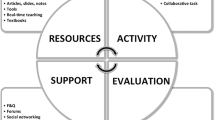Abstract
Recently, there has been an increased interest in producing electronic courses. However, literature shows that adopting e-learning does not guarantee improved learning. This is because mixing technology and content does not necessarily yield effective learning. This paper presents a systematic design process for developing blended courses for undergraduate higher education. The instructional design process is based on instructional design theories and utilized three taxonomies: Bloom Taxonomy, Redeker Taxonomy and Guerra scale. A mapping model is proposed and embedded in the design process to develop a blended course starting from the objectives and content of a traditional course. This paper also presents a evaluation process that estimates the effectiveness of the selected technologies in the design of the blended course. This effectiveness is evaluated in terms of three dimensions: course content formats, interaction and collaboration. A case study is presented to demonstrate the proposed design approach on a System Analysis and Design blended course under development.




Similar content being viewed by others
References
Ally, M. (2008). Foundations of Educational Theory for Online Learning. In T. Anderson (Ed.), Theory and Practice of Online Learning. Athabasca University, 2nd edition.
Anderson, L., & Krathwohl, D. (2001). A taxonomy for Learning, Teaching and Assessing: A revision of Bloom’s taxonomy of Educational Objectives. New York: Addison, Wesley Longman. http://www.techlearning.com/techlearning/archives/2008/04/AndrewChurches.pdf Accessed 25,June, 2010.
Atif, Y., Benlamri, R., & Berri, J. (2003). Learning Objects Based Framework for Self-Adaptive Learning. Education and Information Technologies, 8(4), 345–368.
Blezu, C., & Popa, E. (2008). E-learning and its Prospects in Education, Proceedings of the 12th WSEAS international conference on Computers, July 23–25 (pp. 297–302). Greecez: Heraklion.
Bloom, B., & Krathwohl, D. (1956). Taxonomy of Educational Objectives: The Classification of Educational goals by a Committee of College and University Examiners.” Handbook 1: Cognitive domain. New York, Longmans.
Bower, M. (2008). Designing for Interactive and Collaborative Learning in a Web-Conferencing Environment, PhD thesis, Macquarie University.
Bower, M. (2006). A Learning System Engineering Approach to Developing Online Courses, In Proceedings of Eighth Australasian Computing Education Conference (ACE2006), Hobart, Australia
Branon, R., & Beatty, B., & Wilson, J. (2001). Developing Online Courses: a Human-Centered Approach, Annual Proceedings of Selected Research and Development [and] Practice Papers Presented at the National Convention of the Association for Educational Communications and Technology. Atlanta, GA, November 8–12.
Chiang, G. (2002). What Kind of Support Do They Need? An Instructional Designer’s Experience in Faculty and Student Support for Online Courses. SIGUCCS’02, November 20–23, Providence, USA.
Churches, A. (2008).Bloom's Digital Taxonomy. http://edorigami.wikispaces.com/Bloom%27s+Digital+Taxonomy. Accessed 20 June, 2010.
Graham, C. (2006). Blended Learning Systems: Definition, Current Trends, and Future Directions. In C. J. Bonk & C. R. Graham (Eds.), Handbook of blended learning: Global Perspectives, local designs. San Francisco: Pfeiffer Publishing.
Guerra, T. & Heffernan, D. (2004). The Guerra Scale”. http://www.learningcircuits.org/2004/mar2004/guerra.htm. Accessed 15 March 2010.
Gruenbaum, E. (2010). Predictors of Success for Adult Online Learners: a Review of the Literature. Magazine eLearn, 2010(2).
Hodhod, R., Ibrahim, M., Khafagy, M., et al. (2010). Issues of Choosing the Suitable Virtual Learning Environment. Research Journal of Information Technology, 2(1), 24–29.
Iverson, K., & Colky, D. (2004). Scenario-based E-learning design. Performance Improvement, 43(1), 16–22.
Kulvietiene, R. & Sileikiene I. (2006). The Blended Learning Delivery Design Model, Proceedings of the 6th WSEAS International Conference on Distance Learning and Web Engineering, Lisbon, Portugal, September 22–24.
Molenda, M. (2003). In Search of the Elusive ADDIE Model. Performance improvement, 42(5), 34. http://www.indiana.edu/~molpage/ Accessed 10 March 2010.
Neale, D., Carroll, J., & Rosson, M. (2004). Evaluating computer-supported cooperative work: models and frameworks. Proceedings of the. (2004). ACM conference on computer supported cooperative work (pp. 112–121). Illinois, USA: Chicago.
Paragina, F., Paragina, S., & Jipa, A. (2010). E–learning A New Trend in Teachers Training Activities. Conference proceedings of E-Learning and Software for Education, 1, 115–118.
Piskurich, G. (2003). The AMA Handbook of E-Learning—Effective Design, Implementation, and Technology Solutions. New York: AMACOM AMERICAN MANAGEMENT ASSOCIATION.
Redeker, G. (2003). An Educational Taxonomy for Learning Objects, Proceedings of the 3rd IEEE International Conference on Advanced Learning Technologies (ICALT’03), July 9–11. Greece: Athens.
Ssemugabi, S., & Villiers R. (2007). A Comparative Study of Two Usability Evaluation Methods Using a Web-Based E-Learning Application, Proceedings of SAICSIT, Fish River Sun, South Africa, October 2–3.
Author information
Authors and Affiliations
Corresponding author
Rights and permissions
About this article
Cite this article
El-Ghalayini, H., El-Khalili, N. An approach to designing and evaluating blended courses. Educ Inf Technol 17, 417–430 (2012). https://doi.org/10.1007/s10639-011-9167-7
Published:
Issue Date:
DOI: https://doi.org/10.1007/s10639-011-9167-7




